Land Subsidence Induced by Rapid Urbanization in Arid Environments: A Remote Sensing-Based Investigation
Abstract
:1. Introduction
2. The Climatic, Geologic, Hydrogeologic, and Urban Settings of Riyadh
3. Data and Methods
3.1. Processing of InSAR Data and Extraction of Displacement Rates (Task I)
3.2. Processing of GPS Data to Validate InSAR-Derived Displacement Rates (Task I)
3.3. Urban Land Use Changes between 1992 and 2018 (Task II)
3.4. Spatial Analysis of Relevant Datasets (Task II)
4. Results
4.1. Comparison of SBAS and GPS Velocities
4.2. Subsidence Over Wadis and Lowlands
4.3. Subsidence Over Karstic Topography
4.4. Subsidence Over Dumpsites and Landfills
5. Discussion
6. Conclusions
Author Contributions
Funding
Acknowledgments
Conflicts of Interest
References
- UN. World Economic and Social Survey 2004; UN: New York, NY, USA, 2004. [Google Scholar]
- Güneralp, B.; Seto, K.C. Environmental impacts of urban growth from an integrated dynamic perspective: A case study of Shenzhen, South China. Glob. Environ. Chang. 2008, 18, 720–735. [Google Scholar] [CrossRef]
- Yang, X.; Yue, W.; Xu, H.; Wu, J.; He, Y. Environmental consequences of rapid urbanization in Zhejiang Province, East China. Int. J. Environ. Res. Public Health 2014, 11, 7045–7059. [Google Scholar] [CrossRef] [PubMed]
- Elkadiri, R.; Manche, C.; Sultan, M.; Al-Dousari, A.; Uddin, S.; Chouinard, K.; Abotalib, A.Z. Development of a Coupled Spatiotemporal Algal Bloom Model for Coastal Areas: A Remote Sensing and Data Mining-Based Approach. IEEE J. Sel. Top. Appl. Earth Obs. Remote Sens. 2016, 9, 5159–5171. [Google Scholar] [CrossRef]
- Abidin, H.; Andreas, H.; Gumilar, I.; Sidiq, T.P.; Gamal, M. Environmental impacts of land subsidence in urban areas of Indonesia. In Proceedings of the FIG Working Week, Sofia, Bulgari, 17–21 May 2015; Paper no. 7568. pp. 17–21. [Google Scholar]
- Dang, V.K.; Doubre, C.; Weber, C.; Gourmelen, N.; Masson, F. Recent land subsidence caused by the rapid urban development in the Hanoi region (Vietnam) using ALOS InSAR data. Nat. Hazards Earth Syst. Sci. 2014, 14, 657–674. [Google Scholar] [CrossRef] [Green Version]
- Holzer, T.L.; Johnson, A.I. Land subsidence caused by ground water withdrawal in urban areas. GeoJournal 1985, 11, 245–255. [Google Scholar] [CrossRef]
- Aina, Y.A.; Merwe, J.H.V.; Alshuwaikhat, H.M. Urban Spatial Growth and Land Use Change in Riyadh: Comparing Spectral Angle Mapping and Band Ratioing Techniques. In Proceedings of the Academic Track of the 2008 Free and Open Source Software for Geospatial (FOSS4G) Conference, Incorporating the GISSA 2008 Conference, Cape Town, South Africa, 29 September–3 October 2008; pp. 51–57. [Google Scholar] [CrossRef]
- Hou, H.; Estoque, R.C.; Murayama, Y. Spatiotemporal analysis of urban growth in three African capital cities: A grid-cell-based analysis using remote sensing data. J. Afr. Earth Sci. 2016, 123, 381–391. [Google Scholar] [CrossRef]
- Tawfeek, Y.Q.; Jasim, F.H.; Al-Jiboori, M.H. A study of canopy urban heat Island of Baghdad, Iraq. Asian J. Atmos. Environ. 2020, 14, 280–288. [Google Scholar] [CrossRef]
- UNDESA. World Urbanization Prospects; UNDESA: New York, NY, USA, 2018; Volume 12, ISBN 9789211483192. [Google Scholar]
- Pankratz, H.G.; Sultan, M.; Abdelmohsen, K.; Sauck, W.A.; Alsefry, S.; Alharbi, H.; Emil, M.K.; Gebremichael, E.; Asaeidi, A.; Alshehri, F.; et al. Use of Geophysical and Radar Interferometric Techniques to Monitor Land Deformation Associated with the Jazan Salt Diapir, Jazan city, Saudi Arabia. Surv. Geophys. 2021, 42, 177–200. [Google Scholar] [CrossRef]
- Alahmadi, M.; Atkinson, P.M. Three-fold urban expansion in Saudi Arabia from 1992 to 2013 observed using calibrated DMSP-OLS night-time lights imagery. Remote Sens. 2019, 11, 2266. [Google Scholar] [CrossRef] [Green Version]
- Vaslet, D.; Al-Muallem, M.; Maddah, S.S.; Brosse, J.-M.; Fourniguet, J.; Breton, J.-P.; Le Nindre, Y.-M. Explanatory Notes to the Geologic Map of the Ar Riyad Quadrangle, Sheet 24 I, Kingdom of Saudi Arabia. PDF; Jeddah: Mecca, Saudi Arabia, 1991. [Google Scholar]
- ElKhedr Ibrahim Aeromagnetic data interpretation to locate buried faults in Riyadh region, Saudi Arabia. Sci. Res. Essays 2012, 7. [CrossRef]
- Alkhayyal, Z. Urban Growth Change Analysis of Riyadh, Saudi Arabia: 2005–2015. Saint Mary’s Univ. Minnesota Univ. Cent. Serv. Press 2017, 20, 10. [Google Scholar]
- Cueto, M.; Olona, J.; Fernández-Viejo, G.; Pando, L.; López-Fernández, C. Karst-induced sinkhole detection using an integrated geophysical survey: A case study along the Riyadh metro line 3 (Saudi Arabia). Near Surf. Geophys. 2018, 16, 270–281. [Google Scholar] [CrossRef]
- Papadopoulou, M.P.; Karatzas, G.P.; Bougioukou, G.G. Numerical modelling of the environmental impact of landfill leachate leakage on groundwater quality—A field application. Environ. Model. Assess. 2007, 12, 43–54. [Google Scholar] [CrossRef]
- Jhamnani, B.; Singh, S. Groundwater contamination due to Bhalaswa landfill site in New Delhi. Int. J. Enviorn. Sci. Eng. 2009, 3, 121–125. [Google Scholar]
- Jafari, N.H.; Stark, T.D.; Merry, S. The July 10 2000 Payatas landfill slope failure. Int. J. Geoengin. Case Hist. 2013, 2, 208–228. [Google Scholar] [CrossRef]
- Raviteja, K.V.N.S.; Basha, B.M. Probabilistic back analysis of Koshe landfill slope failure. In Proceedings of the Indian Geotechnical Conference, Guwahati, India, 14–16 December 2017; pp. 1–5. [Google Scholar]
- Yadav, H.; Kumar, P.; Singh, V.P. Hazards from the municipal solid waste dumpsites: A review. In Proceedings of the Lecture Notes in Civil Engineering; Springer: Berlin/Heidelberg, Germany, 2019; Volume 21, pp. 336–342. [Google Scholar]
- Ren, G.; Whittaker, B.N.; Reddish, D.J. Mining subsidence and displacement prediction using influence function methods for steep seams. Min. Sci. Technol. 1989, 8, 235–251. [Google Scholar] [CrossRef]
- Hu, B.; Wang, H.-S.; Sun, Y.-L.; Hou, J.-G.; Liang, J. Long-term land subsidence monitoring of Beijing (China) using the small baseline subset (SBAS) technique. Remote Sens. 2014, 6, 3648–3661. [Google Scholar] [CrossRef] [Green Version]
- Rateb, A.; Abotalib, A.Z. Inferencing the land subsidence in the Nile Delta using Sentinel-1 satellites and GPS between 2015 and 2019. Sci. Total Environ. 2020, 729, 138868. [Google Scholar] [CrossRef]
- Becker, R.H.; Sultan, M. Land subsidence in the Nile Delta: Inferences from radar interferometry. Holocene 2009, 19, 949–954. [Google Scholar] [CrossRef]
- Bhattacharya, A.; Mukherjee, K. Review on InSAR based displacement monitoring of Indian Himalayas: Issues, challenges and possible advanced alternatives. Geocarto Int. 2017, 32, 298–321. [Google Scholar] [CrossRef]
- Zhao, C.; Zhang, Q.; Yang, C.; Zou, W. Integration of MODIS data and short baseline subset (SBAS) technique for land subsidence monitoring in Datong, China. J. Geodyn. 2011, 52, 16–23. [Google Scholar] [CrossRef]
- Wei, L.; Zhang, Y.; Zhao, Z.; Zhong, X.; Liu, S.; Mao, Y.; Li, J. Analysis of mining waste dump site stability based on multiple remote sensing technologies. Remote Sens. 2018, 10, 2025. [Google Scholar] [CrossRef] [Green Version]
- Galloway, D.L.; Burbey, T.J. Review: Regional land subsidence accompanying groundwater extraction. Hydrogeol. J. 2011, 19, 1459–1486. [Google Scholar] [CrossRef]
- Gabriel, A.K.; Goldstein, R.M.; Zebker, H.A. Mapping small elevation changes over large areas: Differential radar interferometry. J. Geophys. Res. 1989, 94, 9183–9191. [Google Scholar] [CrossRef]
- Galloway, D.L.; Hoffmann, J. The application of satellite differential SAR interferometry-derived ground displacements in hydrogeology. Hydrogeol. J. 2007, 15, 133–154. [Google Scholar] [CrossRef] [Green Version]
- Galloway, D.L.; Hudnut, K.W.; Ingebritsen, S.E.; Phillips, S.P.; Peltzer, G.; Rogez, F.; Rosen, P.A. Detection of aquifer system compaction and land subsidence using interferometric synthetic aperture radar, Antelope Valley, Mojave Desert, California. Water Resour. Res. 1998, 34, 2573–2585. [Google Scholar] [CrossRef]
- Fielding, E.J.; Blom, R.G.; Goldstein, R.M. Rapid subsidence over oil fields measured by SAR interferometry. Geophys. Res. Lett. 1998, 25, 3215–3218. [Google Scholar] [CrossRef]
- Othman, A.; Sultan, M.; Becker, R.; Alsefry, S.; Alharbi, T.; Gebremichael, E.; Alharbi, H.; Abdelmohsen, K. Use of geophysical and remote sensing data for assessment of aquifer depletion and related land deformation. Surv. Geophys. 2018, 39, 543–566. [Google Scholar] [CrossRef] [PubMed] [Green Version]
- Othman, A.; Abotalib, A.Z. Land subsidence triggered by groundwater withdrawal under hyper-arid conditions: Case study from Central Saudi Arabia. Environ. Earth Sci. 2019, 78, 243. [Google Scholar] [CrossRef]
- Chen, M.; Tomás, R.; Li, Z.; Motagh, M.; Li, T.; Hu, L.; Gong, H.; Li, X.; Yu, J.; Gong, X. Imaging land subsidence induced by groundwater extraction in Beijing (China) using satellite radar interferometry. Remote Sens. 2016, 8, 468. [Google Scholar] [CrossRef] [Green Version]
- Berardino, P.; Casu, F.; Fornaro, G.; Lanari, R.; Manunta, M.; Manzo, M.; Pepe, A.; Sansosti, E. Small baseline DIFSAR techniques for earth surface deformation analysis. In Proceedings of the FRINGE 2003 Workshop (ESA SP-550), Frascati, Italy, 1–5 December 2003; Volume 550, pp. 7–12. [Google Scholar]
- Lanari, R.; Mora, O.; Manunta, M.; Mallorquí, J.J.; Berardino, P.; Sansosti, E. A small-baseline approach for investigating deformations on full-resolution differential SAR interferograms. IEEE Trans. Geosci. Remote Sens. 2004, 42, 1377–1386. [Google Scholar] [CrossRef]
- Almazroui, M.; Islam, M.N.; Jones, P.D.; Athar, H.; Rahman, M.A. Recent climate change in the Arabian Peninsula: Seasonal rainfall and temperature climatology of Saudi Arabia for 1979–2009. Atmos. Res. 2012, 111, 29–45. [Google Scholar] [CrossRef]
- GTZ/DCO. Detailed Water Resources Studies of Wajid and Overlying Aquifers; Ministry of Water and Electricity: Riyadh, Saudi Arabia, 2009.
- Abotalib, A.Z.; Mohamed, R.S.A. Surface evidences supporting a probable new concept for the river systems evolution in Egypt: A remote sensing overview. Environ. Earth Sci. 2013, 69, 1621–1635. [Google Scholar] [CrossRef]
- Bamousa, A.O. Tectonic and Eustatic Sea-Level Fluctuations during the Early Cretaceous: A Case Study from the Berriasian–Valanginian Sequences in Saudi Arabia; Springer: Cham, Switzerland, 2019; pp. 315–317. [Google Scholar]
- Jado, A.; Johnson, D. Solution caverns in the Dammam Dome, Dhahran, Saudi-Arabia. Arab. J. Sci. Eng. 1983, 8, 69–73. [Google Scholar]
- Grosch, J.J.; Touma, F.T.; Richards, D.P. Solution cavities in the limestone of eastern Saudi Arabia. In Multidisciplinary Conference on Sinkholes and the Environmental Impacts of Karst. 2; A. A. Balkema: Rotterdam, The Netherlands, 1987; pp. 73–78. [Google Scholar]
- Shehata, W.; Bader, T.; Hariri, Z. Principal geological hazards along the Arabian Gulf coast. J. King Abdulaziz Univ. Sci. 1990, 3, 289–302. [Google Scholar] [CrossRef]
- Memesh, A.; Dini, S.M.; Gutiérrez, F.; Wallace, C.A. Evidence of large-scale subsidence caused by interstratal karstification of evaporites in the interior homocline of Central Saudi Arabia. Geophys. Res. Abstr. 2008, 10, A-02276. [Google Scholar]
- Powers, R.W.; Ramirez, L.F.; Redmond, C.D.; Elberg, E.L.J. Geology of the Arabian Peninsula. U.S. Geol. Surv. Prof. Pap. 1966, 560-D, 154. [Google Scholar]
- Kalbus, E.; Oswald, S.; Wang, W.; Kolditz, O.; Engelhardt, I.; Al-saud, M.I.; Rausch, R. Large-scale modeling of the groundwater resources on the Arabian Platform. Int. J. Water Resour. Arid Environ. 2011, 1, 38–47. [Google Scholar]
- Sultan, M.; Sturchio, N.C.; Alsefry, S.; Emil, M.K.; Ahmed, M.; Abdelmohsen, K.; AbuAbdullah, M.M.; Yan, E.; Save, H.; Alharbi, T.; et al. Assessment of age, origin, and sustainability of fossil aquifers: A geochemical and remote sensing-based approach. J. Hydrol. 2019, 576, 325–341. [Google Scholar] [CrossRef]
- Al-Othman, A.A.; Ahmed, I. Hydrogeological framework and its implication on water level rise in Eastern ArRiyadh, Saudi Arabia. Environ. Earth Sci. 2012, 67, 1493–1502. [Google Scholar] [CrossRef]
- Fnais, M.S. Geophysical characteristics of wadi hanifah water system, Riyadh, Saudi Arabia. Arab. J. Geosci. 2011, 4, 1051–1066. [Google Scholar] [CrossRef]
- Al-Harthi, A.A.; Bankher, K.A. Collapsing loess-like soil in western Saudi Arabia. J. Arid Environ. 1999, 41, 383–399. [Google Scholar] [CrossRef] [Green Version]
- Ouda, O.K.M. Treated wastewater use in Saudi Arabia: Challenges and initiatives. Int. J. Water Resour. Dev. 2016, 32, 799–809. [Google Scholar] [CrossRef]
- Ouda, O.K.M.; Cekirge, H.M. Roadmap for development of waste-to energy facility in Saudi Arabia. Am. J. Environ. Eng. 2013, 3, 267–272. [Google Scholar] [CrossRef]
- Ali, A.E.; Abdou Ibrahim, E.E.; Massad, E.M. Mapping waste-disposal sites in Riyadh using radarsat imagery. J. King Saud Univ. Eng. Sci. 2009, 21, 7–13. [Google Scholar] [CrossRef]
- Berardino, P.; Fornaro, G.; Lanari, R.; Sansosti, E. A new algorithm for surface deformation monitoring based on small baseline differential SAR interferograms. IEEE Trans. Geosci. Remote Sens. 2002, 40, 2375–2383. [Google Scholar] [CrossRef] [Green Version]
- Costantini, M.; Rosen, P.A. Generalized phase unwrapping approach for sparse data. In Proceedings of the International Geoscience and Remote Sensing Symposium (IGARSS), Hamburg, Germany, 28 June–2 July 1999; Volume 1, pp. 267–269. [Google Scholar]
- Ferretti, A.; Prati, C.; Rocca, F. Nonlinear subsidence rate estimation using permanent scatterers in differential SAR interferometry. IEEE Trans. Geosci. Remote Sens. 2000, 38, 2202–2212. [Google Scholar] [CrossRef] [Green Version]
- Blewitt, G.; Kreemer, C.; Hammond, W.C.; Gazeaux, J. MIDAS robust trend estimator for accurate GPS station velocities without step detection. J. Geophys. Res. Solid Earth 2016, 121, 2054–2068. [Google Scholar] [CrossRef]
- Dach, R.; Walser, P. Bernese GNSS Software Version 5.2 Tutorial Processing Example Introductory Course Terminal Session; University of Bern: Bern, Switzerland, 2015. [Google Scholar]
- Saleh, M.; Becker, M. A new velocity field from the analysis of the Egyptian Permanent GPS Network (EPGN). Arab. J. Geosci. 2014, 7, 4665–4682. [Google Scholar] [CrossRef]
- Saleh, M.; Becker, M. New constraints on the Nubia-Sinai-Dead Sea fault crustal motion. Tectonophysics 2015, 651, 79–98. [Google Scholar] [CrossRef]
- Altamimi, Z.; Rebischung, P.; Métivier, L.; Collilieux, X. ITRF2014: A new release of the International Terrestrial Reference Frame modeling nonlinear station motions. J. Geophys. Res. Solid Earth 2016, 121, 6109–6131. [Google Scholar] [CrossRef] [Green Version]
- Hollenstein, C.; Kahle, H.-G.; Geiger, A.; Jenny, S.; Goes, S.; Giardini, D. New GPS constraints on the Africa-Eurasia plate boundary zone in southern Italy. Geophys. Res. Lett. 2003, 30. [Google Scholar] [CrossRef]
- Bahrouni, N.; Masson, F.; Meghraoui, M.; Saleh, M.; Maamri, R.; Dhaha, F.; Arfaoui, M. Active tectonics and GPS data analysis of the Maghrebian thrust belt and Africa-Eurasia plate convergence in Tunisia. Tectonophysics 2020, 785, 228440. [Google Scholar] [CrossRef]
- Alothman, A.O.; Fernandes, R.M.; Bos, M.S.; Schillak, S.; Elsaka, B. Angular velocity of Arabian plate from multi-year analysis of GNSS data. Arab. J. Geosci. 2016, 9, 1–10. [Google Scholar] [CrossRef]
- Hegazy, D.; Abotalib, A.Z.; El-Bastaweesy, M.; El-Said, M.A.; Melegy, A.; Garamoon, H. Geo-environmental impacts of hydrogeological setting and anthropogenic activities on water quality in the Quaternary aquifer southeast of the Nile Delta, Egypt. J. Afr. Earth Sci. 2020, 172, 103947. [Google Scholar] [CrossRef]
- Radwan, T.M.; Blackburn, G.A.; Whyatt, J.D.; Atkinson, P.M. Dramatic loss of agricultural land due to urban expansion threatens food security in the Nile Delta, Egypt. Remote Sens. 2019, 11, 332. [Google Scholar] [CrossRef] [Green Version]
- Reilinger, R.; McClusky, S.; Vernant, P.; Lawrence, S.; Ergintav, S.; Cakmak, R.; Ozener, H.; Kadirov, F.; Guliev, I.; Stepanyan, R.; et al. GPS constraints on continental deformation in the Africa-Arabia-Eurasia continental collision zone and implications for the dynamics of plate interactions. J. Geophys. Res. Solid Earth 2006, 111, 1–26. [Google Scholar] [CrossRef]
- ArRajehi, A.; McClusky, S.; Reilinger, R.; Daoud, M.; Alchalbi, A.; Ergintav, S.; Gomez, F.; Sholan, J.; Bou-Rabee, F.; Ogubazghi, G.; et al. Geodetic constraints on present-day motion of the Arabian Plate: Implications for Red Sea and Gulf of Aden rifting. Tectonics 2010, 29, 1–10. [Google Scholar] [CrossRef] [Green Version]
- Scanlon, B.R.; Zhang, Z.; Save, H.; Wiese, D.N.; Landerer, F.W.; Long, D.; Longuevergne, L.; Chen, J. Global evaluation of new GRACE mascon products for hydrologic applications. Water Resour. Res. 2016, 52, 9412–9429. [Google Scholar] [CrossRef]
- Abdelmohsen, K.; Sultan, M.; Ahmed, M.; Save, H.; Elkaliouby, B.; Emil, M.; Yan, E.; Abotalib, A.Z.; Krishnamurthy, R.V.; Abdelmalik, K. Response of deep aquifers to climate variability. Sci. Total Environ. 2019, 677, 530–544. [Google Scholar] [CrossRef] [PubMed]
- Havazli, E.; Wdowinski, S. Detection threshold estimates for insar time series: A simulation of tropospheric delay approach. Sensors (Switzerland) 2021, 21, 1124. [Google Scholar] [CrossRef]
- Ouda, O.K.M. Water demand versus supply in Saudi Arabia: Current and future challenges. Int. J. Water Resour. Dev. 2014, 30, 335–344. [Google Scholar] [CrossRef]
- Saxena, N.C. Subsidence Management Handbook; Scientific Publishers: Rajasthan, India, 2018; ISBN 9789387869462/9387869466. [Google Scholar]
- Abdeltawab, S. Karst limestone geohazards in Egypt and Saudi Arabia. Int. J. Geoengin. Case Hist. 2013, 2, 258–269. [Google Scholar] [CrossRef]
- Abd El Aal, A. Identification and characterization of near surface cavities in Tuwaiq mountain limestone, Riyadh, KSA, “detection and treatment. ” Egypt. J. Pet. 2017, 26, 215–223. [Google Scholar] [CrossRef] [Green Version]
- Abd El-Aal, A.K.; Masoud, A.A. Impacts of karst phenomena on engineering properties of limestone foundation bed, Ar Riyadh, Saudi Arabia. Arab. J. Geosci. 2017, 10, 1–17. [Google Scholar] [CrossRef]
- Tatiya, R.R. Surface and Underground Excavations; CRC Press: Boca Raton, FL, USA, 2005. [Google Scholar]
- Zhou, W.; Beck, B.F. Engineering issues on karst. In Karst Management; Springer: Cham, The Netherlands, 2011; pp. 9–45. [Google Scholar]
- Newton, J.G. Development of sinkholes resulting from man’s activities in the Eastern United States. US Geol. Surv. Circ. 1987, 968. [Google Scholar]
- Parise, M.; Closson, D.; Gutiérrez, F.; Stevanović, Z. Anticipating and managing engineering problems in the complex karst environment. Environ. Earth Sci. 2015, 74, 7823–7835. [Google Scholar] [CrossRef]
- Waltham, T.; Waltham, A.C.; Bell, F.G.; Culshaw, M.G. Sinkholes and Subsidence: Karst and Cavernous Rocks in Engineering and Construction; Springer: Cham, The Netherlands, 2005. [Google Scholar]
- Algarni, D.A.; Ali, A.E. Mapping waste-disposal sites using SPOT remote sensor data: Riyadh case. J. King Saud Univ. Eng. Sci. 1998, 10, 15–29. [Google Scholar] [CrossRef]
- Bian, Q.; Alharbi, B.; Shareef, M.M.; Husain, T.; Pasha, M.J.; Atwood, S.A.; Kreidenweis, S.M. Sources of PM2.5 carbonaceous aerosol in Riyadh, Saudi Arabia. Atmos. Chem. Phys. 2018, 18, 3969–3985. [Google Scholar] [CrossRef] [Green Version]
- Loni, O.A.; Hussein, M.T.; Alrehaili, A.M. Geo-environmental effect of landfill site, southeast of Riyadh, Saudi Arabia. Arab. J. Geosci. 2013, 6, 2021–2033. [Google Scholar] [CrossRef]
- Shin, B.W.; Lee, B.J.; Bae, W.S.; Lee, J.K.; Ahn, B.-C. The settlement characteristics of waste landfill site by consolidation test. J. Korean GEO Environ. Soc. 2000, 1, 35–42. [Google Scholar]
- Cho, Y.-K.; Chae, Y.S. Analysis of long-term settlement parameter correlation and bearing capacity reinforcement effect for closed waste landfill. J. Korean Geosynth. Soc. 2013, 12, 1–10. [Google Scholar] [CrossRef] [Green Version]
- Baek, W.-K.; Jung, H.-S.; Jo, M.-J.; Lee, W.-J.; Zhang, L. Ground subsidence observation of solid waste landfill park using multi-temporal radar interferometry. Int. J. Urban Sci. 2019, 23, 406–421. [Google Scholar] [CrossRef]
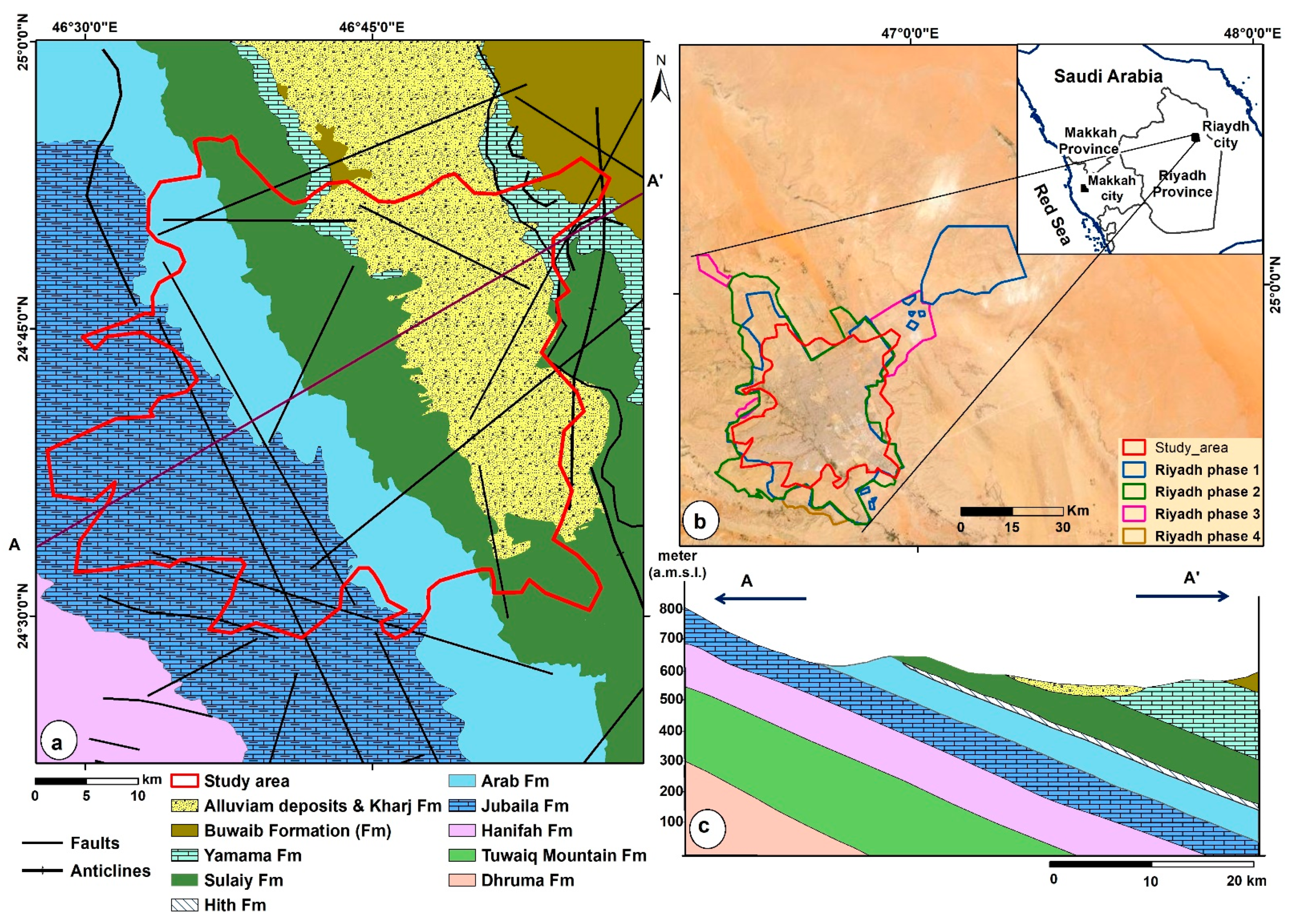
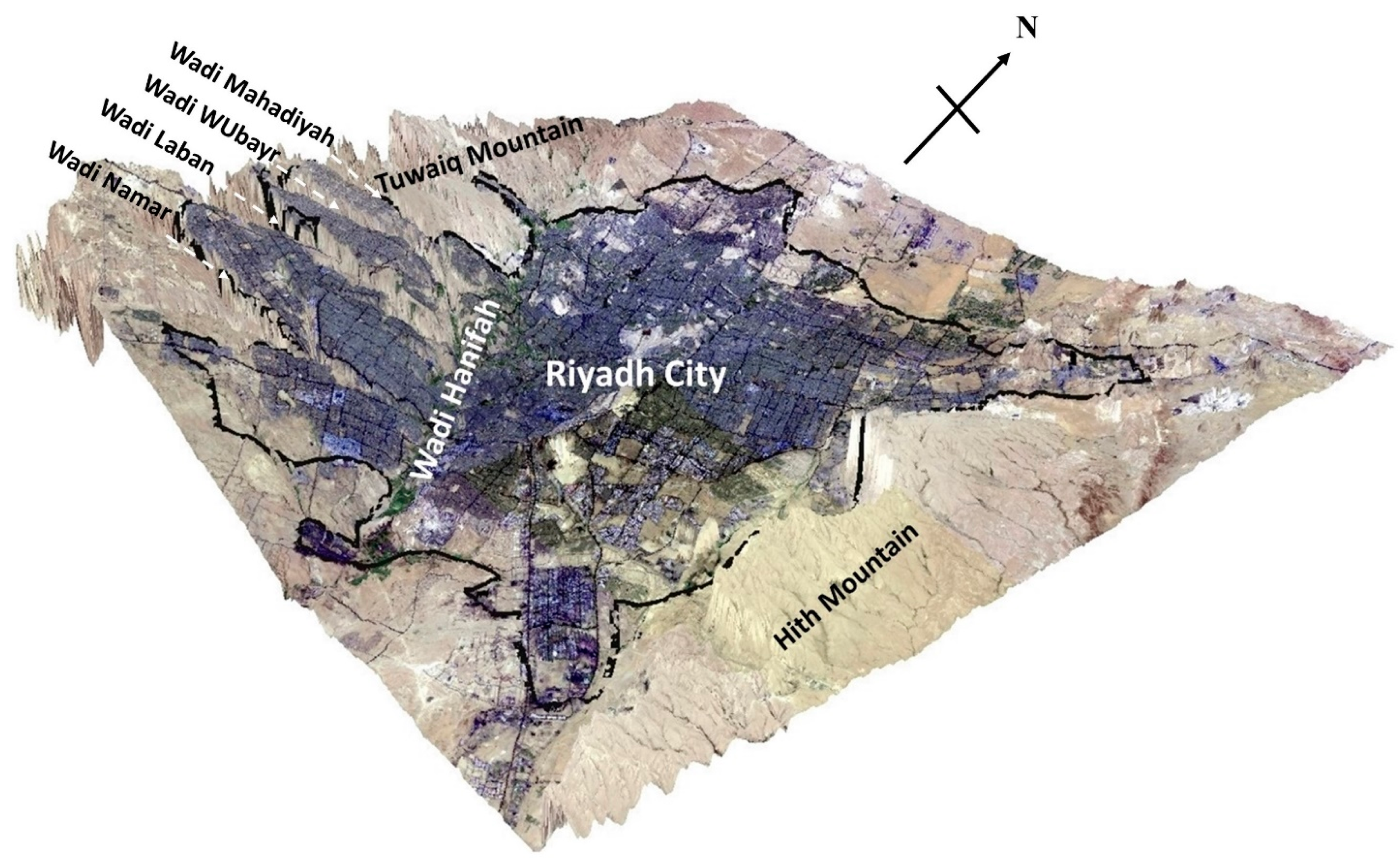


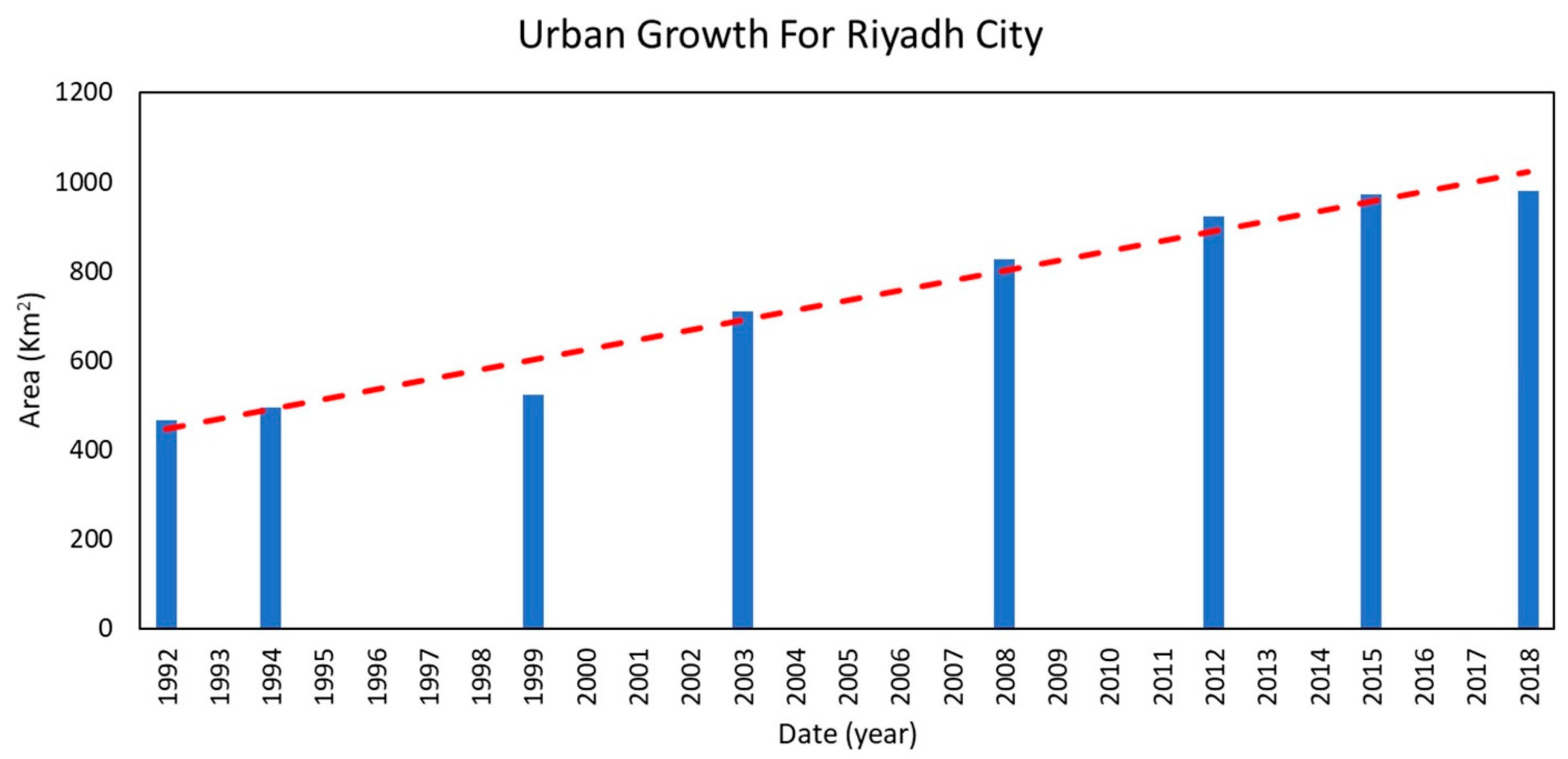
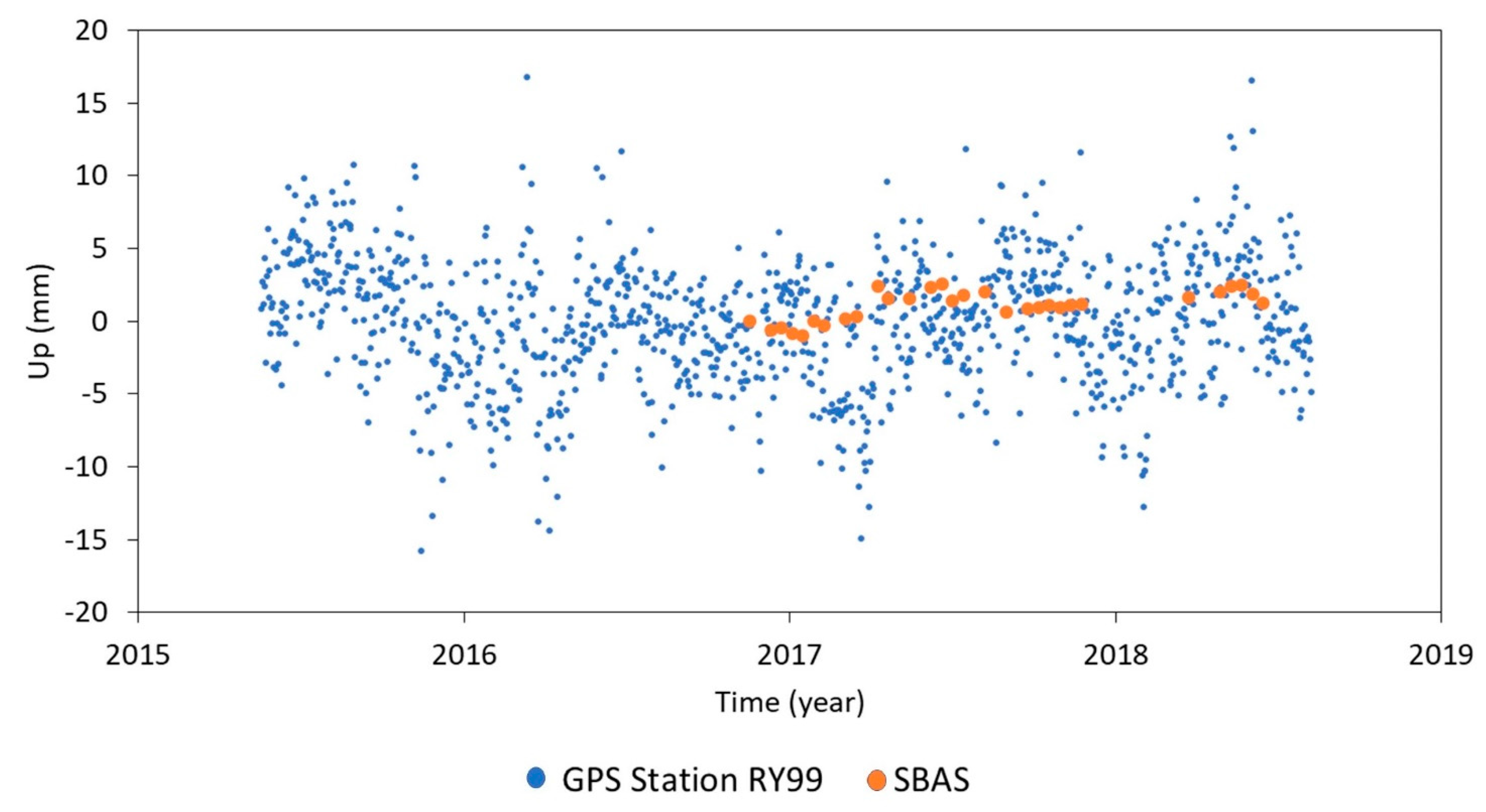

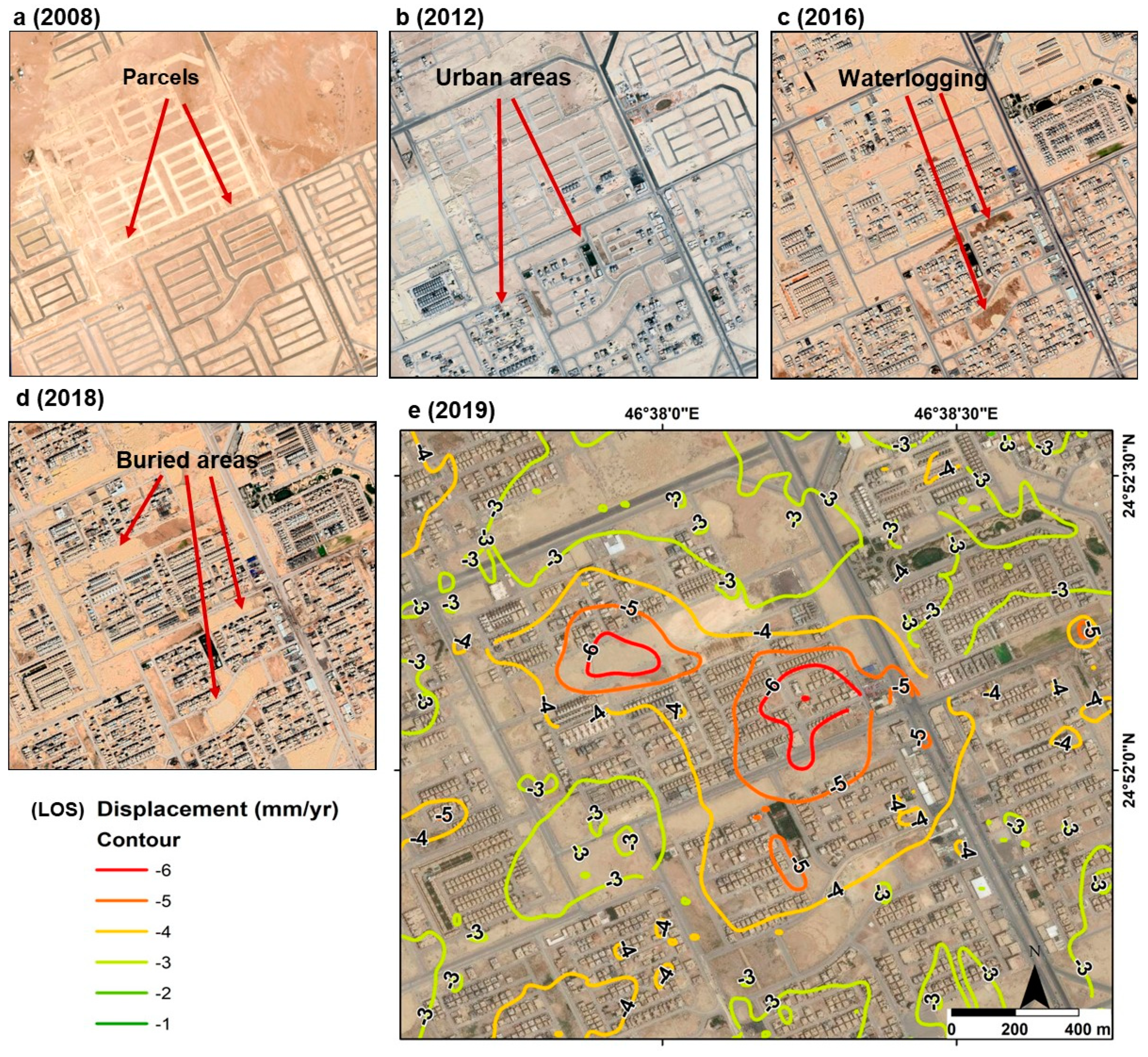



| SR# | Mission | Orbit | Day | Month | Year | Comment |
|---|---|---|---|---|---|---|
| 1 | Sentinel (1A) | 013969 | 16 | 11 | 2016 | Scenes used |
| 3 | Sentinel (1A) | 014319 | 10 | 12 | 2016 | |
| 4 | Sentinel (1A) | 014494 | 22 | 12 | 2016 | |
| 5 | Sentinel (1A) | 014669 | 03 | 01 | 2017 | |
| 6 | Sentinel (1A) | 014844 | 15 | 01 | 2017 | |
| 7 | Sentinel (1A) | 015019 | 27 | 01 | 2017 | |
| 8 | Sentinel (1A) | 015194 | 08 | 02 | 2017 | |
| 10 | Sentinel (1A) | 015544 | 04 | 03 | 2017 | |
| 11 | Sentinel (1A) | 015719 | 16 | 03 | 2017 | |
| 13 | Sentinel (1A) | 016069 | 09 | 04 | 2017 | |
| 14 | Sentinel (1A) | 016244 | 21 | 04 | 2017 | |
| 15 | Sentinel (1A) | 016594 | 15 | 05 | 2017 | |
| 17 | Sentinel (1A) | 016944 | 08 | 06 | 2017 | |
| 18 | Sentinel (1A) | 017119 | 20 | 06 | 2017 | |
| 19 | Sentinel (1A) | 017294 | 02 | 07 | 2017 | |
| 20 | Sentinel (1A) | 017469 | 14 | 07 | 2017 | |
| 21 | Sentinel (1A) | 017819 | 07 | 08 | 2017 | |
| 23 | Sentinel (1A) | 018169 | 31 | 08 | 2017 | |
| 25 | Sentinel (1A) | 018519 | 24 | 09 | 2017 | |
| 26 | Sentinel (1A) | 018694 | 06 | 10 | 2017 | |
| 27 | Sentinel (1A) | 018869 | 18 | 10 | 2017 | |
| 28 | Sentinel (1A) | 019044 | 30 | 10 | 2017 | |
| 29 | Sentinel (1A) | 019219 | 11 | 11 | 2017 | |
| 30 | Sentinel (1A) | 019394 | 23 | 11 | 2017 | |
| 31 | Sentinel (1A) | 021144 | 23 | 03 | 2018 | |
| 34 | Sentinel (1A) | 021669 | 28 | 04 | 2018 | |
| 35 | Sentinel (1A) | 021844 | 10 | 05 | 2018 | |
| 36 | Sentinel (1A) | 022019 | 22 | 05 | 2018 | |
| 37 | Sentinel (1A) | 022194 | 03 | 06 | 2018 | |
| 38 | Sentinel (1A) | 022369 | 15 | 06 | 2018 | |
| 0 | Sentinel (1A) | 009944 | 14 | 02 | 2016 | Scenes eliminated |
| 2 | Sentinel (1A) | 014144 | 28 | 11 | 2016 | |
| 9 | Sentinel (1A) | 015369 | 20 | 02 | 2017 | |
| 12 | Sentinel (1A) | 015894 | 28 | 03 | 2017 | |
| 16 | Sentinel (1A) | 016769 | 27 | 05 | 2017 | |
| 22 | Sentinel (1A) | 017994 | 19 | 08 | 2017 | |
| 24 | Sentinel (1A) | 018344 | 12 | 09 | 2017 | |
| 32 | Sentinel (1A) | 021319 | 04 | 04 | 2018 | |
| 33 | Sentinel (1A) | 021494 | 04 | 16 | 2018 |
| # | Site | Latitude | Longitude | Area | Subsidence * (mm/y) |
|---|---|---|---|---|---|
| 1 | W1 | 24°38′38.709″ N | 46°31′51.384″ E | Wadi Wubay | −4 to −9 |
| 2 | W2 | 24°41′44.044″ N | 46°36′22.379″ E | Wadi Hanifah | −1 to −4 |
| 3 | W3 | 24°39′32.734″ N | 46°33′24.014″ E | Wadi Wubay | −2 to −8 |
| 4 | W4 | 24°39′55.499″ N | 46°34′18.458″ E | Wadi Wubay | −1 to −7 |
| 5 | W5 | 24°39′5.564″ N | 46°35′12.577″ E | Wadi Hanifah | −1 to −9 |
| 6 | W6 | 24°38′27.016″ N | 46°34′52.182″ E | Wadi Hanifah | −1 to −18 |
| 7 | W7 | 24°38′41.857″ N | 46°35′51.722″ E | Wadi Hanifah | −2 to −9 |
| 8 | W8 | 24°36′21.642″ N | 46°36′39.024″ E | Wadi Laban | −2 to −6 |
| 9 | W9 | 24°35′55.154″ N | 46°31′55.488″ E | Wadi Laban | −1 to −4 |
| 10 | W10 | 24°34′15.424″ N | 46°36′11.816″ E | Wadi Namar | −1 to −13 |
| 11 | W11 | 24°35′20.698″ N | 46°39′3.233″ E | Wadi Hanifah | −1 to −6 |
| 12 | W12 | 24°33′40.369″ N | 46°37′38.978″ E | Wadi Namar | −1 to −6 |
| 13 | W13 | 24°35′44.25″ N | 46°31′18.543″ E | Wadi Laban | −1 to −6 |
| 14 | W14 | 24°50′58.932″ N | 46°54′44.591″ E | Al Janadriyah | −3 to −5 |
| 15 | L1 | 24°41′4.59″ N | 46°53′8.083″ E | Khashm Al An | −1 to −7 |
| 16 | L2 | 24°51′3.42″ N | 46°37′52.625″ E | An Narjis | −2 to −4 |
| 17 | L3 | 24°51′36.777″ N | 46°37′49.09″ E | An Narjis | −1 to −4 |
| 18 | L4 | 24°49′33.448″ N | 46°39′44.518″ E | Al Yasmin | −1 to −7 |
| 19 | L5 | 24°52′57.178″ N | 46°38′13.64″ E | An Narjis | −3 to −5 |
| 20 | L6 | 24°52′41.952″ N | 46°37′22.343″ E | An Narjis | −3 to −5 |
| 21 | L7 | 24°52′9.118″ N | 46°38′11.129″ E | An Narjis | −3 to −6 |
| 22 | L8 | 24°51′22.118″ N | 46°36′46.65″ E | An Narjis | −1 to −7 |
| 23 | L9 | 24°51′58.132″ N | 46°37′30.828″ E | An Narjis | −3 to −5 |
| 24 | L10 | 24°45′16.158″ N | 46°37′56.401″ E | An Nakhil | −1 to −5 |
| 25 | L11 | 24°33′44.12″ N | 46°32′12.723″ E | Tuwaiq | −2 to −4 |
| 26 | L12 | 24°33′43.813″ N | 46°31′28.054″ E | Tuwaiq | −3 to −4 |
| 27 | L13 | 24°32′53.479″ N | 46°31′13.872″ E | Tuwaiq | −2 to −5 |
| 28 | K1 | 24°51′41.453″ N | 46°34′33.728″ E | Al Qirawan | −3 to −5 |
| 29 | K2 | 24°51′46.361″ N | 46°33′51.911″ E | Al Qirawan | −2 to −5 |
| 30 | K3 | 24°51′8.338″ N | 46°33′46.788″ E | Al Qirawan | −3 to −10 |
| 31 | K4 | 24°50′23.807″ N | 46°34′9.237″ E | Al Qirawan | −1 to −8 |
| 32 | K5 | 24°49′50.841″ N | 46°35′45.102″ E | Al Qirawan | −2 to −5 |
| 33 | D1 | 24°46′0.131″ N | 46°54′3.156″ E | Ar Rimayah | −1 to −6 |
| 34 | D2 | 24°49′48.788″ N | 46°43′1.198″ E | Qurtubah | −1 to − 4 |
| 35 | LF1 | 24°31′24.093″ N | 46°40′29.554″ E | Al Marwah | −1 to −21 |
| 36 | LF2 | 24°29′44.341″ N | 46°41′9.629″ E | Al Marwah | −1 to −11 |
| 37 | LF3 | 24°37′32.879″ N | 46°53′56.093″ E | As Sulay | −1 to −21 |
| 38 | LF4 | 24°36′47.926″ N | 46°47′8.627″ E | Al Manakh | −1 to −9 |
| # | Stations | Latitude | Longitude | GPS Velocity mm/y | Standard Deviation mm/y | ||||
|---|---|---|---|---|---|---|---|---|---|
| Ve | Vn | Vu | |||||||
| 1 | ADIS | 09°02′06.00″ N | 38°45′57.59″ E | 24.64 | 18.83 | −3.20 | 0.27 | 0.17 | 0.48 |
| 2 | ANKR | 39°53′13.20″ N | 32°45′28.80″ E | 3.00 | 11.57 | −4.43 | 0.59 | 0.22 | 0.79 |
| 3 | BHR3 | 26°12′32.39″ N | 50°36′28.79″ E | 31.11 | 30.32 | −0.18 | 0.10 | 0.08 | 0.31 |
| 4 | BHR4 | 26°12′32.39″ N | 50°36′28.79″ E | 31.03 | 30.32 | −0.10 | 0.09 | 0.06 | 0.57 |
| 5 | BSHM | 32°46′44.40″ N | 35°01′22.80″ E | 22.65 | 19.87 | 0.25 | 0.09 | 0.10 | 0.46 |
| 6 | GRAZ | 47°04′01.20″ N | 15°29′34.80″ E | 22.51 | 15.18 | 1.81 | 0.12 | 0.09 | 0.38 |
| 7 | IISC | 13°01′15.60″ N | 77°34′11.99″ E | 42.32 | 35.71 | −1.19 | 0.16 | 0.11 | 0.52 |
| 8 | ISBA | 33°20′27.60″ N | 44°26′16.80″ E | 24.84 | 28.39 | −0.36 | 0.15 | 0.19 | 0.57 |
| 9 | MAL2 | 02°59′45.59″ S | 40°11′38.40″ E | 26.13 | 16.15 | −0.42 | 0.12 | 0.15 | 0.62 |
| 10 | MARS | 43°16′44.40″ N | 05°21′14.40″ E | 20.08 | 15.85 | −0.35 | 0.12 | 0.08 | 0.39 |
| 11 | MAS1 | 27°45′50.39″ N | 15°37′58.79″ W | 17.13 | 16.92 | −0.39 | 0.19 | 0.08 | 0.41 |
| 12 | MBAR | 00°36′03.60″ S | 30°44′16.79″ E | 25.58 | 17.91 | 0.62 | 0.11 | 0.17 | 0.49 |
| 13 | RAMO | 30°35′52.79″ N | 34°45′46.79″ E | 23.86 | 19.23 | 1.35 | 0.13 | 0.15 | 0.38 |
| 14 | RY99 | 24°40′26.39″ N | 46°41′38.40″ E | 31.48 | 29.71 | −0.15 | 0.08 | 0.19 | 0.34 |
| 15 | SOFI | 42°33′21.59″ N | 23°23′41.99″ E | 24.02 | 11.43 | 0.56 | 0.24 | 0.11 | 0.37 |
| 16 | TEHN | 35°41′49.20″ N | 51°20′02.40″ E | 26.82 | 19.14 | −2.43 | 0.36 | 0.27 | 0.65 |
| 17 | YEBE | 40°31′29.99″ N | 03°05′20.39″ W | 19.27 | 15.96 | 0.75 | 0.16 | 0.06 | 0.28 |
Publisher’s Note: MDPI stays neutral with regard to jurisdictional claims in published maps and institutional affiliations. |
© 2021 by the authors. Licensee MDPI, Basel, Switzerland. This article is an open access article distributed under the terms and conditions of the Creative Commons Attribution (CC BY) license (http://creativecommons.org/licenses/by/4.0/).
Share and Cite
Aljammaz, A.; Sultan, M.; Izadi, M.; Abotalib, A.Z.; Elhebiry, M.S.; Emil, M.K.; Abdelmohsen, K.; Saleh, M.; Becker, R. Land Subsidence Induced by Rapid Urbanization in Arid Environments: A Remote Sensing-Based Investigation. Remote Sens. 2021, 13, 1109. https://doi.org/10.3390/rs13061109
Aljammaz A, Sultan M, Izadi M, Abotalib AZ, Elhebiry MS, Emil MK, Abdelmohsen K, Saleh M, Becker R. Land Subsidence Induced by Rapid Urbanization in Arid Environments: A Remote Sensing-Based Investigation. Remote Sensing. 2021; 13(6):1109. https://doi.org/10.3390/rs13061109
Chicago/Turabian StyleAljammaz, Abdulaziz, Mohamed Sultan, Moein Izadi, Abotalib Z. Abotalib, Mohamed S. Elhebiry, Mustafa Kemal Emil, Karem Abdelmohsen, Mohamed Saleh, and Richard Becker. 2021. "Land Subsidence Induced by Rapid Urbanization in Arid Environments: A Remote Sensing-Based Investigation" Remote Sensing 13, no. 6: 1109. https://doi.org/10.3390/rs13061109









